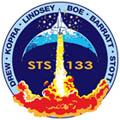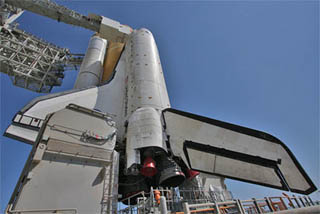 Orbiter: Discovery Mission: STS-133 Payload: Leonardo Launch: Feb. 24, 2011 Time: 4:50 p.m. EST Site: Pad 39A, Kennedy Space Center Landing: March 7 @ approx. 12:36 p.m. Site: KSC's Shuttle Landing Facility  
|
Mission Status Center
Welcome to Spaceflight Now's live coverage of space shuttle Discovery's STS-133 mission to the International Space Station. Text updates will appear automatically; there is no need to reload the page. TUESDAY, FEBRUARY 1, 2011
With repairs to its external tank complete, engineers began hauling the shuttle Discovery back to launch pad 39A Monday evening for work to ready the ship for blastoff Feb. 24 on a flight to deliver critical spare parts, supplies and a final U.S. module to the International Space Station.
Read our full story. Check out Spaceflight Now's two photo galleries of Discovery's rollout: 0755 GMT (2:55 a.m. EST)
For the 45th and final time in her long spaceflight career, the shuttle Discovery has trekked to Kennedy Space Center's launch pad for another voyage into Earth orbit.
Bolted to a giant external fuel tank and twin solid rocket boosters atop a mobile launching platform, Discovery embarked on the three-and-a-half-mile trip at 7:58 p.m. EST. The shuttle had been returned to the Vehicle Assembly Building just before Christmas to have its external tank checked out and repaired after tiny cracks halted the initial launch attempt on November 5. Technicians worked for the past several weeks to digitally X-ray the trouble area around the tank's ribbed midsection, add doublers over the cracked support beams and install modifications around the entire intertank region to strengthen it. "The team worked very hard to get us to a point where we're ready to get back out to the launch pad," Stephanie Stilson, Discovery's flow director, said in an interview during rollout. "I feel very confident in the work they did. The processes we put in place to ensure that are very good. So now it's just a matter of getting back out to the launch pad, going through our normal routine." An Apollo-era transporter carried the shuttle stack along the rock-covered crawlerway leading to the oceanfront launch complex at barely a walking pace. Powerful hydraulics jacked up the platform, keeping it level as the crawler ascended the pad's concrete incline. A laser alignment system helped technicians precisely position the platform, then the crawler lowered it onto the pad's pedestals to complete Discovery's rollout at 2:53 a.m. EST. Since Discovery already spent three months on the launch pad awaiting this mission, several key prelaunch activities won't have to be repeated. The payloads have remained packed inside the shuttle's cargo bay, the orbiter's maneuvering propellants stayed loaded and the countdown dress rehearsal doesn't need to be reperformed. But Stilson said the extensive testing procedures to ensure a space shuttle is ready for flight will be conducted again. "We still have a lot of work in front of us, but we're feeling confident." One interest bit of work ahead includes swapping out the spacewalking suit and personal items already aboard Discovery for astronaut Tim Kopra. He was injured in a bicycle accident and has been replaced by Steve Bowen for the mission. In the next few hours and days, the methodical process of hooking up the crew module assess and hydrogen vent arms extending from the launch tower, as well as electrical, propellant, communications and other lines between the ground systems and mobile launch platform will begin. The gantry-like rotating service structure will be closed later this morning. The schedule between now and launch has five days of slack set aside as margin. "That's a good amount," Stilson said. "That will give us a little breathing room if we hit any challenges along the way." Liftoff is scheduled for 4:50 p.m. EST on February 24. 0753 GMT (2:53 a.m. EST)
The mobile launch platform was "harddown" on the pad pedestals at 2:53 a.m. EST, marking the official time for Discovery's arrival at pad 39A.
0740 GMT (2:40 a.m. EST)
The platform is slowly inching down to the pedestals.
0738 GMT (2:38 a.m. EST)
Measurements taken do verify the platform is a good position. The rollout crew is ready to lower the crawler down.
0729 GMT (2:29 a.m. EST)
The Apollo-era crawler has finished tonight's drive from the Vehicle Assembly Building, delivering space shuttle Discovery atop launch pad 39A. But the rollout's official conclusion time will be marked when the launch platform is lowered down and secured to the pad pedestals.
0720 GMT (2:20 a.m. EST)
The crawler is getting the mobile launch platform positioned over the pad pedestals where Discovery will be perched for its February 24 blastoff.
0705 GMT (2:05 a.m. EST)
Discovery has ascended the incline to launch pad 39A, its crawler-transporter having used massive hydraulic pistons to keep the mobile platform level.
Now atop the pad surface, a precision laser guidance system will help align the platform over the pad pedestals. The crawler will lower the platform onto the pedestals to complete the rollout. 0635 GMT (1:35 a.m. EST)
The crawler transporter is climbing the concrete ramp to the launch pad with space shuttle Discovery.
0625 GMT (1:25 a.m. EST)
Here's some more photos of Discovery leaving the VAB taken by Spaceflight Now's Stephen Clark.
0615 GMT (1:15 a.m. EST)
Discovery has reached the pad perimeter gate.
0555 GMT (12:55 a.m. EST)
The crawler is making the curve to reach the entrance to launch pad 39A.
0550 GMT (12:50 a.m. EST)
Check out Discovery rollout photos taken tonight from the Kennedy Space Center press site by Spaceflight Now's Justin Ray.
0539 GMT (12:39 a.m. EST)
Crawler is propelling again.
0520 GMT (12:20 a.m. EST)
The crawler has stopped for a few minutes to grease a bearing that getting a little hot.
0415 GMT (11:15 p.m. EST Mon.)
Discovery is passing by the Kennedy Space Center's Visitor Center observation gantry as the rollout proceeds smoothly. That's where the crawlerway forks into two pathways -- go left to pad 39B or straight ahead to pad 39A.
0330 GMT (10:30 p.m. EST Mon.)
Hauling the shuttle stack out to launch pad 39A on this 3.5-mile trek is one of NASA's two Apollo-era crawler-transporters. The combined weight of the transporter, mobile launch platform and shuttle Discovery is 17.5 million pounds.
The stone-covered pathway connecting the VAB to the launch pad is 130 feet wide -- almost as broad as an eight-lane highway. Two 40-foot-wide lanes are separated by a 50-foot-wide median strip. The average depth is seven feet. About 30 people are aboard the transporter to operate it during the rollout, including three drivers -- a prime and backup in the front cabin and one in the rear -- a jacking and leveling operator, a control room operator to run crawler systems and talk with the Launch Control Center, two electricians, two electronic technicians and four diesel mechanics for starting, monitoring and shutting down the transporter's engines. The other team members are mechanics watching over the roll and helping with the platform's docking to the launch pad. The transporter consumes 126 gallons of diesel fuel in each mile it travels from the VAB to pad. The vehicle has a fuel capacity of 5,000 gallons. 0228 GMT (9:28 p.m. EST Mon.)
The transporter is making good progress now 90 minutes into the rollout.
0200 GMT (9:00 p.m. EST Mon.)
A giant crowd space center employees and their family members gathered along the crawlerway as space shuttle Discovery headed eastward tonight.
Officials handed out 900 car passes for workers to escort viewers to Discovery's final rollout. 0120 GMT (8:20 p.m. EST Mon.)
Space shuttle Discovery has emerged from the 52-story landmark Vehicle Assembly Building where it spent the past five weeks having the external fuel tank inspected, repaired and strengthened.
0058 GMT (7:58 p.m. EST Mon.)
ROLLOUT BEGINS. The crawler-transporter has started moving the space shuttle Discovery from the cavernous Vehicle Assembly Building to Kennedy Space Center's launch pad 39A for the ship's final flight before retirement.
0056 GMT (7:56 p.m. EST Mon.)
The mobile launch platform has been jacked to travel height for leaving the Vehicle Assembly Building. First motion of rollout expected any moment now.
0048 GMT (7:48 p.m. EST Mon.)
There's now space between the VAB pedestals and launch platform as the crawler literally picks up the space shuttle.
0040 GMT (7:40 p.m. EST Mon.)
All is in readiness for rollout to begin shortly. And the gate just outside the VAB on the crawlerway is being opened now to let Discovery out.
0024 GMT (7:24 p.m. EST Mon.)
Permission has been granted for the crawler-transporter to start hydraulically lifting the mobile launch platform off of the Vehicle Assembly Building pedestals.
0015 GMT (7:15 p.m. EST Mon.)
Observers are being deployed to their locations around the Vehicle Assembly Building for monitoring the shuttle's departure.
0010 GMT (7:10 p.m. EST Mon.)
Final ground umbilicals between the mobile launch platform and the Vehicle Assembly Building are being unplugged.
2345 GMT (6:45 p.m. EST)
The rollout crew anticipates being ready for observers to report for duty around 7:15 p.m. EST.
2330 GMT (6:30 p.m. EST)
The sun has set over the Kennedy Space Center as workers begin arriving with their families at the special viewing site arranged outside the VAB. And news photographers are boarding the bus for the ride across the street from the press site to the VAB for covering tonight's rollout.
2310 GMT (6:10 p.m. EST)
Power is being transferred over to the mobile equipment from the ground-fed sources in the VAB.
2300 GMT (6:00 p.m. EST)
The crawler's hydraulics has been jacked up to the preparatory waypoint just two inches under the mobile launch platform.
2255 GMT (5:55 p.m. EST)
The work is going smoothly and the rollout could begin as early as 7:45 p.m. EST.
2250 GMT (5:50 p.m. EST)
Moving a key step closer to the rollout, the crawler has propelled itself into place below the shuttle. Later in the preparations, the crawler's hydraulics will lift the shuttle platform off the VAB pedestals.
2230 GMT (5:30 p.m. EST)
The rollout team is getting the crawler-transporter moved into the Vehicle Assembly Building and positioned beneath shuttle Discovery's mobile launch platform.
2210 GMT (5:10 p.m. EST)
The crawler-transporter is fired up and running on internal power. It should be ready to drive into the Vehicle Assembly Building shortly.
2145 GMT (4:45 p.m. EST)
The giant sliding doors of the Vehicle Assembly Building has been opened up for Discovery's departure this evening. Meanwhile, the crew for the crawler-transporter, which is parked just outside, is starting work to ready that machine for the heavy-lifting move to the pad.
2100 GMT (4:00 p.m. EST)
It is call-to-stations time for the rollout team. The various members are reporting for duty to begin the final four hours of preparations leading to tonight's planned 8 p.m. EST first motion of the space shuttle rollout.
2035 GMT (3:35 p.m. EST)
Weather forecasters are predicting fine conditions for Discovery's rollout from the Vehicle Assembly Building tonight. The outlook includes some scattered low clouds, broken decks of mid- and high-level clouds, good visibility, southeasterly winds of 8 to 12 knots and a temperature in the low 60s falling into the high 50s F.
There is no chance of any lightning in the area or violating the wind limits. 2015 GMT (3:15 p.m. EST)
With repairs to its external tank complete, engineers geared up Monday to haul the shuttle Discovery back to launch pad 39A for work to ready the ship for blastoff Feb. 24 on a flight to deliver critical spare parts, supplies and a final U.S. module to the International Space Station.
Read our full story. 1615 GMT (11:15 a.m. EST)
NASA has cleared the space shuttle Discovery for rollout to Kennedy Space Center's launch pad 39A tonight beginning at 8 p.m. EST.
The ground team responsible for moving the spacecraft along the 3.5-mile stone-covered roadway from the Vehicle Assembly Building to the seaside pad is scheduled to report for duty at 4 p.m. The crawler-transporter will hydraulically lift the mobile launching platform and carry the shuttle on the six-hour trip. If all goes according to plan, Discovery should be secured atop the pad and the swing arms extended long before dawn. Watch this page for live coverage! SUNDAY, JANUARY 30, 2011
With the external tank repaired and strengthened, the space shuttle Discovery is ready to re-emerge from the Vehicle Assembly Building on Monday evening and return to launch pad 39A for a final pre-retirement mission to the International Space Station.
The ship had retreated to the 52-story VAB on December 22 to have the full ribbed midsection of the tank digitally X-rayed after tiny structural cracks broke the covering foam during the initial launch attempt on November 5. Those VAB inspections uncovered four more cracks on the tank's backside that couldn't be inspected at the pad because of limited access. Extensive troubleshooting and testing into the oddity took a couple months to determine the cause of the cracking, keeping Discovery grounded in the process. NASA now believes the particular batch of material used in the ribbed beams on this tank and pent up stresses accumulated during construction combined to create the problem. "We absolutely have root cause and we have been able to show that through test," said John Shannon, the shuttle program manager. "It's a combination of two factors. It's the low fracture toughness of the material, we have about 65 percent of the expected fracture toughness, combined with some assembly stresses that were built up in different areas."
WEDNESDAY, JANUARY 26, 2011
Updated listing of shuttle Discovery's upcoming launch windows.
Here is a detailed timeline of shuttle Discovery's launch countdown for Feb. 24 liftoff. Shuttle Discovery's launch events timeline for climb to orbit. Read our earlier status center coverage. |

Space video for your computer, iPod or big screen TV
Experience the space program like never before become a subscriber today |
